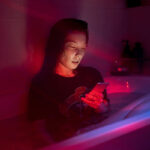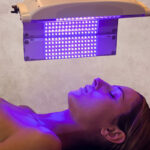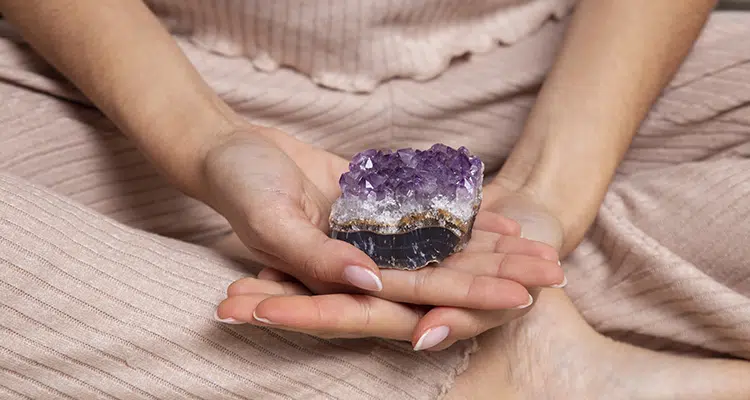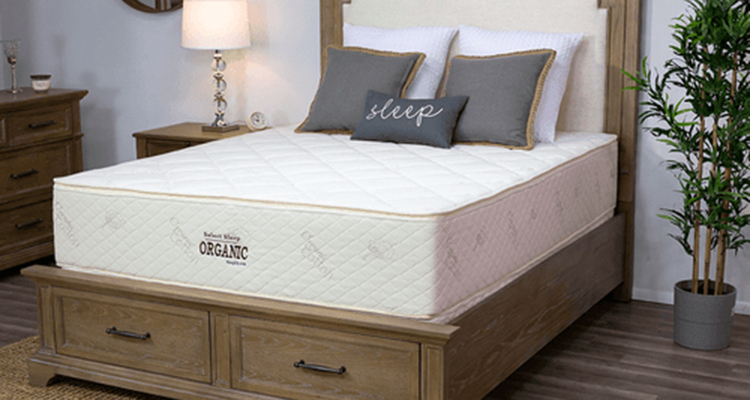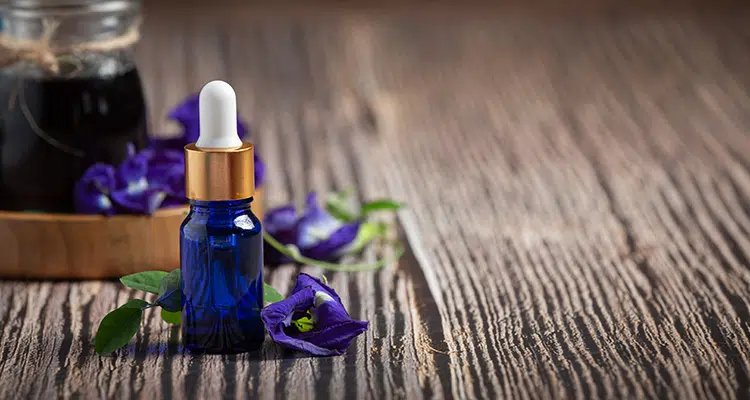Understanding and Preventing Blue Light Insomnia
Over 5 billion people have cellphones across the world and the average person uses their device over 3 hours per day. That’s a lot of screen time! While staring at a screen is part of most people’s everyday lives, it can also be doing damage to your health and sleep quality.
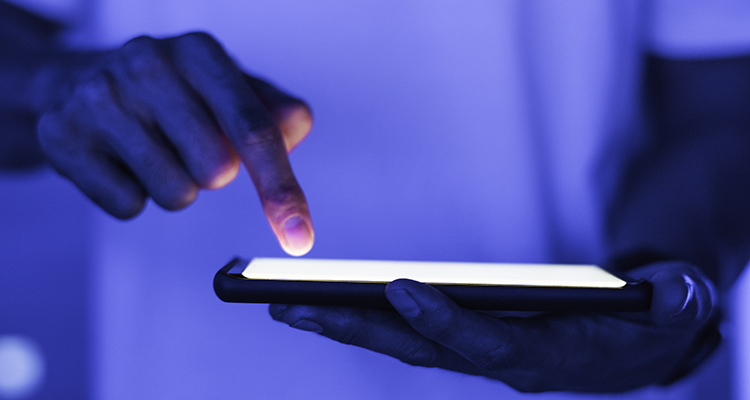
In addition to cell phone use, most people use a computer or tablet for work and watch TV or play video games for fun. Increased screen time also means an increased risk of eye strain, headaches, poor posture, and sleep disturbances.
In this article, we’ll discuss what blue light insomnia is, exactly what causes it, and how lifestyle changes can help ease symptoms so you can finally achieve the deep, restorative sleep you need.
Content
What is Blue Light?
You may have heard of blue light before but don’t really know what it is. Despite what the name suggests, blue light isn’t a bright beam of, well, blue light! Instead, it’s actually the type of light emitted from electronic devices and screens like cellphones, televisions, and computers. In small doses, this light doesn’t cause any adverse side effects or significant harm. However, exposure to blue light at night or right before bed prevents your brain from releasing a hormone called melatonin, which induces sleep. Without it, many people struggle to fall and stay asleep.
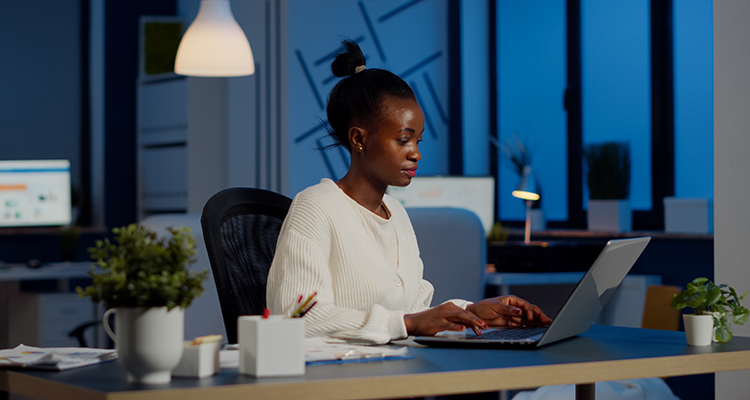
Blue light also interferes with your natural sleep cycle which is regulated by the rising and setting of the sun. Exposure to artificial light too close to bedtime tricks your mind into thinking it’s daytime and you should be awake and alert rather than winding down and preparing for sleep.
From a scientific standpoint, all light is made up of electromagnetic radiation – an invisible form of energy. Your eye processes different colors of light based on energy levels. For example, a rainbow represents all the colors of the visible light spectrum whereas white light from the sun is actually a combination of colors. Blue light is just a small portion of the visible light spectrum that affects hormone production, alertness, and your sleep cycle. Blue light is emitted from electronic devices, fluorescent lights, and LED lights. Other common sources of blue light include video game consoles, televisions, computer screens, tablets, smartphones, and e-readers. At least 90% of people admit to using one of these devices either in bed or within an hour of trying to fall asleep. What many don’t realize is that doing so is sabotaging their sleep cycle and ability to achieve quality rest.
More on Blue Light and Sleep
Now that you know what blue light is, what devices emit it, and that it may be causing your insomnia, let’s dive deeper into exactly how and why blue light interrupts your natural sleep patterns.
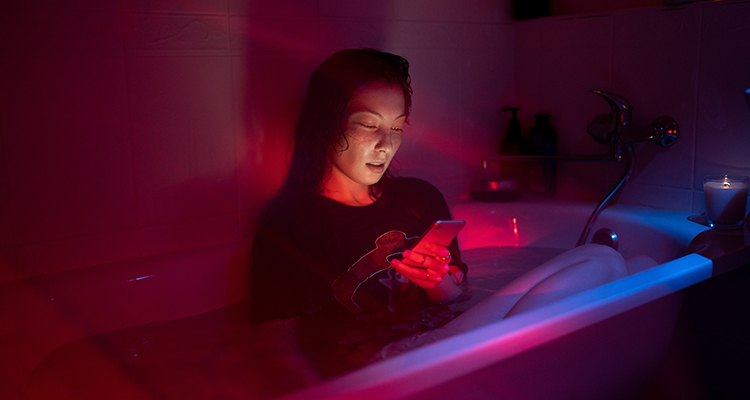
You can’t discuss the effect of blue light on sleep without mentioning your body’s circadian rhythm. This 24-hour cycle is what helps regulate your sleeping patterns and allows you to perform necessary daily tasks and functions. Light has the biggest impact on your circadian rhythm since it imitates the natural light from the sun. Light triggers your brain and body to be awake and aroused. Darkness, like the sunset, indicates it’s time for rest and sleep. Artificial light, including blue light, confuses your brain into thinking you should be awake when, in reality, it may be time for bed.
The blue light emitted from electronics and screens most closely resembles the light from the sun, which is why exposure to these devices has the biggest impact on your sleep patterns. Blue light directly stimulates the part of the brain associated with alertness and arousal. When this happens, both your heart rate and body temperature increase. During the day, blue light is beneficial for improving focus, attention, and overall performance. It also promotes a healthy circadian rhythm by setting you up for quality sleep once the sun sets. In fact, light exposure therapy is used to treat certain sleep disorders, including insomnia. Circadian rhythm sleep disorders occur when your sleep-wake cycle is out of alignment with your environment. Blue light can help reverse this imbalance. (More on this in a minute).
Blue light doesn’t just increase your body temperature and heart rate – it also prevents your body from releasing melatonin, the sleep hormone that triggers drowsiness. Using your smartphone, laptop, or watching television in bed can interfere with your body’s natural ability to prepare for sleep. Even after you turn these devices off, the effects of blue light exposure can still be felt for some time. Over time, a misaligned circadian rhythm can cause health issues including metabolic disorders and even mental health conditions like anxiety or depression.
How Does Blue Light Sleep Therapy Work?
While blue light has gotten a bad rap for causing insomnia and making it difficult to fall asleep, you can also use the effects of blue light to your advantage. This is known as blue light therapy and may help treat certain sleep disorders.
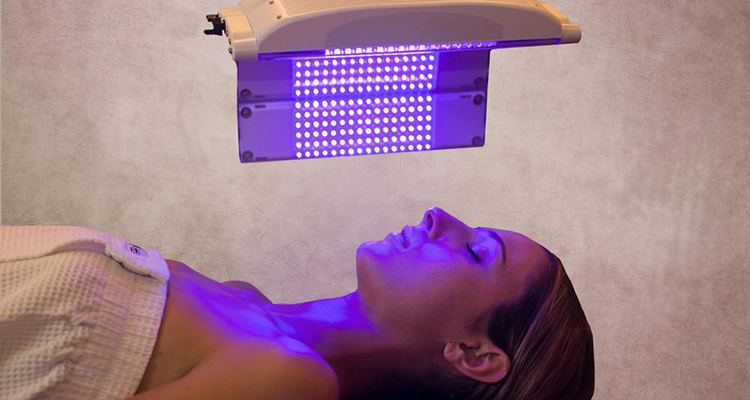
Participants with a circadian rhythm misalignment sit in front of a light therapy lamp or lightbox that emits light similar to natural sunlight. Patients can sit 2 to 3 feet from the box and don’t need to stare directly into the light. In fact, having the light in your peripheral vision is best. Blue light therapy may also help correct delayed sleep phase syndrome which is marked by the inability to fall asleep until the early hours of the next morning, like 2:00 or 3:00 a.m. Advanced sleep phase syndrome is another common disorder that makes it difficult to stay awake at night. Patients may fall asleep very early at night (7:00 p.m.) and wake extremely early in the morning without being able to fall back to sleep (3:00 or 4:00 a.m.). Some evidence suggests that blue light therapy may also help those working shift work or suffering from jet lag.
Blue light therapy can be used to reset your circadian rhythm, helping you stay awake until a reasonable time at night and also wake at a productive time in the morning, feeling alert and focused. For example, 20 minutes of light therapy at night can help those suffering from advanced sleep phase syndrome stay awake later. Light therapy in the morning can promote wakefulness and may be beneficial for those who need to fall asleep earlier at night.
Using Blue Light to Your Advantage
In addition to the above mentioned side effects, too much vitamin C can cause other negative interactions in your body. This is especially true if you’re currently taking other medications.
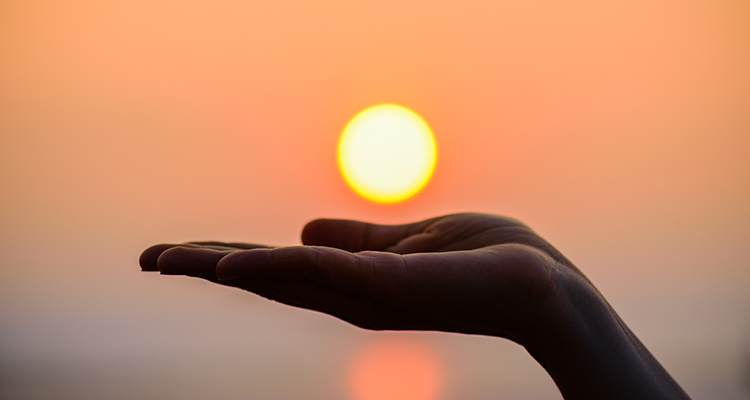
Get Plenty of Daytime Sun Exposure
The best way to prevent a circadian rhythm misalignment is to get plenty of daily light exposure. While the best type is natural sunlight, bright lights come in at a close second. Anytime you’re outside in the sunlight, be sure to protect yourself and your skin using sunscreen. The sun’s UV rays are beneficial but can also be harmful if you don’t take the proper precautions. Even on cloudy days, the sun’s rays can peek through enough to help you feel more aroused and awake but can also cause a sunburn, so be diligent with your skin care routine.
Start your day off right with light exposure that promotes alertness and wakefulness. Take a walk, enjoy your morning coffee or tea outside, or, if possible, work outdoors. If you can’t, set up your work desk or laptop near a window where natural light shines through. Remember, the blue light from your computer and phone will also prompt wakefulness. Being more alert during the morning hours sets your body and mind up for a productive day followed by a restful night.
Limit Blue Light Exposure at Night
The best insomnia treatment for sleep disturbances brought on by blue light is to avoid exposure at night. Get your full of using your smartphone, playing video games, or using your laptop during the daytime hours. Once evening settles in and the sun goes down, it’s important to limit exposure as much as possible. Set a technology curfew for yourself that includes turning off all devices and electronics at least 60 minutes before bed.
Instead of reading on a Kindle or tablet, read from a regular book. Write in a journal, do a puzzle, or listen to soft soothing music with your eyes closed. Other relaxation techniques include meditation, mindfulness and stretching. All of these activities will help your mind and body wind down and prepare for sleep.
If personal obligations keep you from completely turning off your devices at night, you can still make minor changes to prevent blue light from disturbing your sleep. Try switching your smartphone or tablet to “night mode” or “dark mode”. This will adjust the brightness of the screen, reducing how much blue light you’re exposed to.
Avoid Stimulating Activities and Screens
When it comes to blue light exposure at night, certain activities, apps, and devices may be more beneficial than others. For example, apps like TikTok, Instagram, or YouTube showcase stimulating videos, bright lights, flashing images, and arousing music. Instead of using these types of apps before bed, opt for a relaxing meditation or mindfulness app or soothing music. You can use these beneficial tools without staring at your device. The blue light exposure of these tools is minimal compared to hours of playing video games or scrolling your social media feeds.
Limiting blue light exposure at night doesn’t mean completely eliminating the things you love. It means being intentional about your choices so you can enjoy the benefits of both relaxing activities and a quality night’s sleep.
Other Ways to Prevent Blue Light Insomnia and Promote Sleep
Being mindful about when you expose yourself to blue light isn’t the only way to help combat it’s negative effects on your circadian rhythm and achieve quality sleep. Here are a few more ways to mitigate blue light insomnia and achieve deep, restorative sleep.
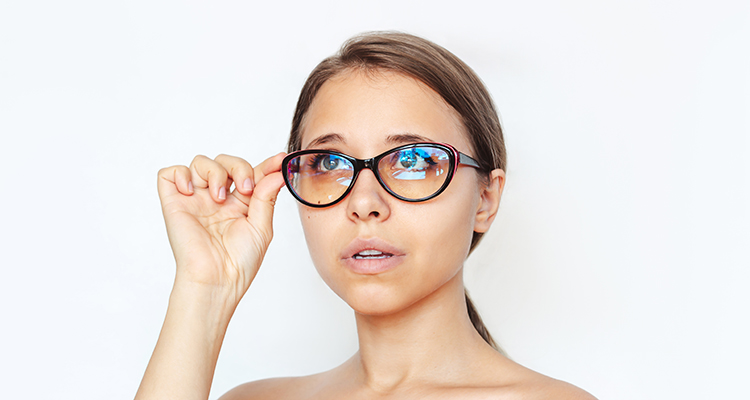
Blue Light Glasses
Blue light glasses have increased in popularity over the last few years as more people work from home, homeschool their children, and rely on electronics for work and play. As the name suggests, blue light blocking glasses are designed to filter out blue light emitted from screens and digital devices. Filters work to block the transmission of different wavelengths. These glasses may also prevent glare which causes increased eye strain and headaches. If you have to use your digital devices at night, reduce the negative effects of blue light exposure by investing in a pair of these affordable glasses.
Utilize Red Light
While blue light has adverse side effects on your sleep patterns, red light may actually offer some useful benefits. Red light can help stabilize your circadian rhythm and has less of an impact on the release of melatonin. Try swapping certain light bulbs throughout your house for red ones like the lamp beside your bed or any nightlights you use to illuminate the path to the bathroom or hallways of your home.
Set a Consistent Sleep Schedule
In addition to using light to your advantage, setting a sleep schedule is the next best way to align your circadian rhythm. The goal here is to help your body adjust to a natural sleep-wake schedule that includes going to bed around the same time every night and waking up at the same time every morning. By doing so, your body will start to naturally relax and unwind at night and wake to feel alert and rested.
Setting a sleep schedule during the week may be easier since most people have a certain work schedule they follow. But it’s important to remain consistent with your sleep schedule even on your days off, weekends, and while traveling. Try to go to bed within the same hour every night – for example, between 9:30 p.m. and 10:30 p.m. Every morning, set your alarm for the same time and try to get up rather than hit the snooze button. A tip for achieving this is to set your alarm clock or cellphone across the room. That way, you have to get up in order to turn it off and you’re more likely to stay awake and get your day started right.
Adopt Healthy Habits and Routines
Setting a bedtime and avoiding blue light too close to bedtime are two effective ways to combat insomnia and regulate your circadian rhythm. The more consistent and relaxing your nighttime routine is, the more likely you are to achieve the quality sleep you need without interruption.
Adopt healthy habits both during the day and at night. As previously mentioned, start your day with light exposure. Exercising in the morning is another great way to boost your energy and also promote better sleep at night. Avoid taking naps during the day or overloading on caffeine to combat drowsiness. Instead, opt for natural ways of boosting energy like eating healthy, well-balanced meals and getting plenty of physical activity.
When night falls, follow a consistent, relaxing routine that promotes sleep and helps you unwind from your busy day. A nighttime walk, meditation, journaling, problem solving activities like doing a puzzle, reading from a book, or taking a warm, soothing bath are all great ways to prepare for sleep. By adding these activities to your nightly routine, your body will soon recognize them as triggers for sleep. Set an alarm to remind yourself to turn off all digital devices at least 60 minutes before bed, although some experts argue you should switch screens off 2 to 3 hours prior to sleep.
Design Your Sleep Environment with Purpose
Once it’s time to crawl into bed and close your eyes, you want to enter a relaxing, welcoming environment. That means creating a bedroom that’s conducive for sleep. You know yourself best. Choose colors and fabrics that soothe you. Invest in a comfortable mattress and quality sheets and bedding. This will make it easier to find a comfortable sleeping position. Eliminate distractions using a white noise machine or room darkening shades.
Reserve your bed for sleep and sex only. That means no snacking, working, or watching TV while sitting up in bed. Doing so will help solidify the connection between your bed and sleep rather than your bed and other activities that require you to be alert and focused. Another way to support this mind-body connection is to avoid lying in bed awake for more than 15 to 20 minutes. If you’re struggling to fall asleep, get up and perform a relaxing activity. Avoid turning on too many bright lights or utilize red lights as previously mentioned. Once you feel tired enough to sleep, return to bed. Continue this until you fall asleep before hitting that 20-minute mark.
Say Goodbye to Blue Light Insomnia and Hello to Blissful Sleep
The days (or should we say nights?) of lost sleep are gone! Now that you know how blue light impacts your circadian rhythm, you can make minor adjustments to your lifestyle that will have a big impact on how well you sleep.
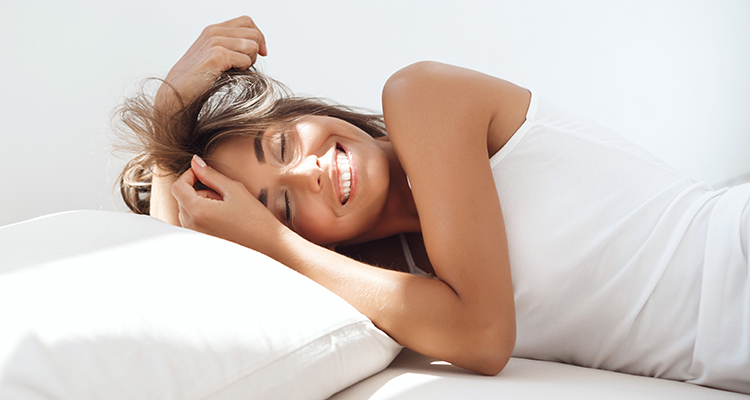
In addition to these changes, the therapy and treatment techniques used at Somnus Therapy will facilitate your journey. We use a variety of approaches to help you identify, understand, and overcome your sleep troubles.
Click here to learn more.
https://www.health.harvard.edu/staying-healthy/blue-light-has-a-dark-side
https://www.webmd.com/sleep-disorders/sleep-blue-light
https://www.sleepfoundation.org/bedroom-environment/blue-light
https://www.everydayhealth.com/sleep/blue-light-what-is-it-and-how-does-it-affect-your-sleep/
https://www.healthline.com/nutrition/block-blue-light-to-sleep-better


